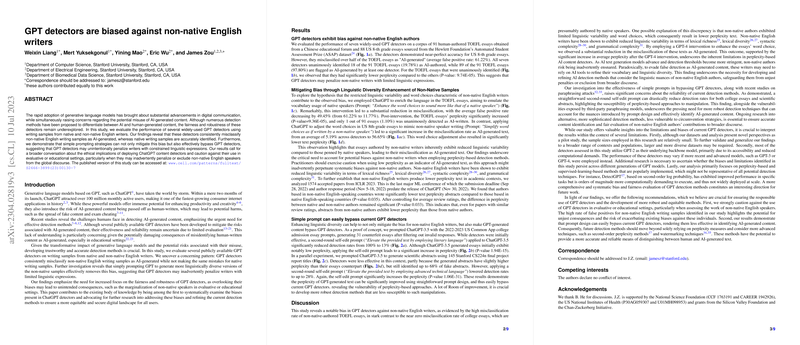Bias in GPT Detectors Against Non-Native English Writers
The paper "GPT detectors are biased against non-native English writers" by Weixin Liang et al. scrutinizes the performance of various GPT detectors, aligning focus on their differential efficacy in identifying human and AI-generated content across samples authored by native and non-native English speakers. The paper presents compelling evidence of bias within these detectors, particularly against non-native English writers, as manifested in the misclassification of their work as AI-generated. This misclassification poses significant ethical concerns, especially in domains like academia and professional writing, where such biases could unfairly disadvantage non-native English speakers.
Key Findings and Methodology
The researchers evaluated seven widely-used GPT detectors by testing 91 human-authored TOEFL essays from a Chinese educational platform and 88 essays from the Hewlett Foundation's Automated Student Assessment Prize (ASAP) dataset, representing native English writers. Notably, the detectors demonstrated high accuracy in identifying the latter as human-written. However, they misclassified a substantial number of TOEFL essays as AI-generated, yielding an average false positive rate of 61.22%. This discrepancy indicates the detectors' bias against non-native authors, attributing lower perplexity scores to their texts, which led to higher false positives.
In addition, the paper utilized GPT to enhance the language complexity of non-native writing samples, significantly reducing the false positive rate by over 49% with increased text perplexity post-intervention. Conversely, simplifying the language in native essays increased misclassification rates to AI-generated levels, suggesting that linguistic simplicity and reduced diversity inherent in non-native writing is a primary bias driver.
Manipulation and Vulnerability of Detection Systems
The paper further investigates how linguistic adjustments can easily bypass current detectors, shedding light on their inherent vulnerabilities. Through simple self-edit prompts, AI-generated text from GPT-3.5 crossed detection barriers upon linguistic refinement, reducing detection efficacy from perfect rates to as low as 13% for one set of tests. Similar trends were observed with scientific abstracts, confirming the inefficacy of perplexity-based methods under strategic manipulation.
Implications and Future Directions
The research underscores the need for improvement in AI content detection methodologies. Current detectors, reliant on linguistic complexity and perplexity measures, fall short in addressing content nuances introduced by non-native writing patterns. This reliance risks unfair penalties for non-native speakers, inadvertently pushing them towards AI assistance for acceptable text standards — hence perpetuating a paradox of reliance on AI to evade AI detection.
Considering these biases, the paper emphasizes the importance of developing robust detection systems resistant to manipulation by leveraging alternative strategies like second-order perplexity and watermarking techniques. Moreover, a shift in the discourse surrounding AI detectors in educational and evaluative contexts is essential to prevent systemic bias against non-native speakers.
Conclusion
This paper raises fundamental questions about the fairness and robustness of existing AI detection systems. The highlighted bias against non-native English authors, alongside vulnerabilities to prompt-based manipulations, demands innovative approaches and ethical considerations in deploying such technologies. Enhancing the inclusivity and accuracy of AI content detectors will ensure equitable participation in the global communication landscape, safeguarding against the marginalization of non-native authors. Future research in this domain should strive to devise more sophisticated and equitable detection methodologies, prioritizing fairness and robustness to allow for diverse linguistic expression across all users.
